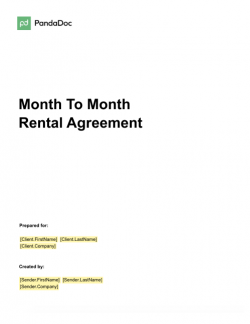Oklahoma Month-to-Month Lease Agreement
An Oklahoma month-to-month lease agreement is a crucial document that defines the responsibilities and rights of landlord and tenant when leasing a property. Our template provides all the legal terms and clauses these documents must contain.

Month-to-Month Leases in Oklahoma
Lease Termination & Renewal
- Either party must provide at least 30 days’ written notice to terminate the lease. Often, the party must deliver the notice personally to incur receipt of the notice. If the other party cannot receive it, you can also post it to their registered address.
Rent Increases
- While there’s no legal requirement for the notice period when increasing the rent, the law does require such notice to be in writing. Generally, landlords abide by a 30-day notice period, but they can also state another period in the agreement.
Security Deposit
- Oklahoma implemented new security deposit laws. These laws state that the landlord can charge higher security deposits. While it prevents excessive deposits, it does ensure fair amounts and better security. Further, the lessor must provide the tenant with an itemized statement of deductions.
- They must detail any deductions and the reasons for them. They must also provide copies of receipts and statements for repairs or services they perform using the security deposit. Further, the landlord must return the deposit within 45 days of terminating the lease.
Tenant Rights
- The tenant has the right to a safe and healthy living environment.
- The landlord must conduct any repairs that materially harm the tenant’s health within 14 days. Otherwise, they can move out 30 days after sending the notice. Further, if the landlord agrees to provide utilities, they cannot withhold them.
Required Disclosures
Besides the above terms, you must add a few legal disclosures to the contract. Without these disclosures, the agreement can become null and void.
- Identity: The landlord must disclose his or the property’s managing party’s name and address. It allows for tenants to serve legal notices.
- Demolition Notice: The landlord must disclose it if they plan on displacing tenants within six months of signing this lease. It can be due to demolition, renovation, or other adjustments.
- Shared Utilities: The lessor must provide a detailed breakdown of utility fees if the unit has shared utilities with other units.
- Mold Disclosure: Landlords must disclose in the move-in inventory if there’s any visible evidence of mold on the property.
- Move-in Checklist: Landlords must provide the tenant a checklist upon moving in. It allows the tenants to take inventory of any existing damages on the property.
- Methamphetamine: The lessor must disclose if they know of meth contamination or production on the property.
- Lead-Based Paint: All lessors of buildings built before 1978 must provide a pamphlet on lead-based paint.

